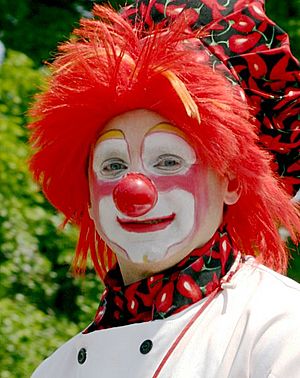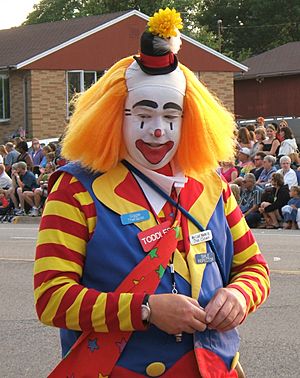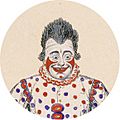Clown facts for kids
Clowns are funny performers who make people laugh. You can see them almost anywhere, doing all sorts of things! They often perform in circuses, rodeos, at children's parties, or even on the street.
Clowns often wear special makeup and costumes. They might have big shoes, oversized clothes, or a funny nose. Their humor is usually visual, meaning they use their bodies and actions to be funny, like in physical comedy or slapstick. It's interesting that many clowns avoid blue face paint, as some think it brings bad luck!
Contents
The History of Clowns

Clowning has been around for a very long time, in almost every culture! In many cultures, clowns were part of festivals or special ceremonies. In Europe, clowns were common everyday characters, especially during carnivals, even up to the 1800s.
One early type of clown was the fool. This role goes back to ancient Egypt. These fools were sometimes people with physical or mental differences. They were often cared for by local lords. Even though they were sometimes made fun of, they were often the only people in court who could speak freely without getting into trouble.
By the 1500s, especially in France, actors started training to be fools. This allowed them to make funny comments about society or leaders. This is where we get the idea of the court jester. Jesters often danced, did acrobatics, and even juggled!
Where the Word "Clown" Comes From
The word "clown" comes from old words that meant "clot" or "clod." These words also came to mean a "clumsy person."
The word "clown" can be used in different ways. It can be a noun (like "a clown"), a verb (like "to clown around"), or even an adjective (like "clown shoes"). When professional clowns talk about a "clown," they often mean the funny character they play, not just the person performing.
Famous Clown Sayings
- "Clowns are the pegs on which circuses hang." — P. T. Barnum
- "A clown is like aspirin, only he works twice as fast." — Groucho Marx
- "It is Meat and Drink for me to see a Clown." — William Shakespeare
Rodeo Clowns
A rodeo clown has one of the most dangerous jobs in entertainment! They are brave cowboys or animal wranglers. They wear wild, loose-fitting clothes to protect themselves and to distract rodeo bulls and broncos.
The loose layers of their clothing help them shed parts of their outfit if a bull's horn snags it. Their main job is to protect other performers from bucking horses and charging bulls. At the same time, they entertain the audience with their funny clown acts!
Clowns in Popular Culture
Clowns appear in many types of entertainment. For example, Pagliacci is an opera (a play with singing) about clowns. The song "The Tears of a Clown" by Smokey Robinson and Stevie Wonder was inspired by this theme. Red Skelton was a popular entertainer who performed clown acts on television.
Many clowns became famous outside of the circus. These include Emmett Kelly, Coco the Clown, and George Carl. George Carl was an American clown who became very successful in Europe. He even performed for the Queen in London and received a special "Golden Clown" award from Princess Grace of Monaco!
Ronald McDonald is a famous clown character. He is the mascot for McDonald's restaurants.
Images for kids
-
Joseph Grimaldi as "Joey" the Clown, c. 1810
-
Joseph Grimaldi as Clown, showing his own make-up design (1820)
-
Swedish actor Gösta Ekman senior (1890-1938) as a whiteface clown in the play Han som får örfilarna (He Who Gets Slapped) by Leonid Andreyev (1926)
-
10-year-old Swedish actress Inger Nilsson during her visit to Helsinki, Finland in February 1970; she is here seen with the Finnish clown Onni Gideon in Helsinki Ice Hall
-
1968 postcard, main cast of Bozo's Circus (WGN-TV); left to right, Ringmaster Ned (Ned Locke), Mr. Bob (bandleader Bob Trendler), Bozo the Clown (Bob Bell), Oliver O. Oliver (Ray Rayner), Sandy the Clown (Don Sandburg)
-
Clown of Düsseldorf
See also
 In Spanish: Payaso para niños
In Spanish: Payaso para niños






















